

The Future of Blood Diagnostics is Here



Meet the Quadruple Aim in Diabetes Care with In-office HbA1c and uACR
Better outcomes. Lower costs. Better patient experience. Better clinician experience.

Diabetes management solutions at the point-of-care
Gain insights into your patient’s current status with real-time actionable results.
DCA Vantage® Analyzer
Rapid assessment of glycemic control and kidney health
HbA1c
• CLIA-waived
Albumin-to-creatinine ratio (ACR)
• CLIA Moderate Complexity
CLINITEK Status® Connect System
CLIA-waived analyzer for routine urinalysis, including kidney health
• CLINITEK® Microalbumin 2 Strip (ACR)

The Prevalence of Diabetes Among U.S. Adults is on the Rise1
Help your patients reverse the trend
Customize your patient consultations to enhance physician-patient partnership toward improved outcomes.

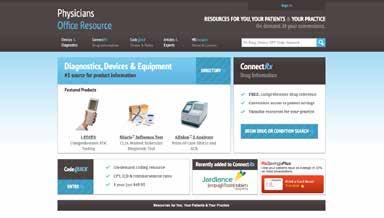

Getting the most from this guide
There are two simple ways to request information about the products and services found in Physicians Office Resource.
1. Go to www.PhysiciansOfficeResource.com and enter the four-digit reference number found next to the product or service into the search field, then request additional information, schedule a demo, or speak with a sales agent all with just a simple click of a button.
2. Find the Business Reply Card in this issue, circle the desired reference numbers, complete the form, and drop into any USPS mailbox. A representative will contact you as quickly as possible to answer your questions. www.PhysiciansOfficeResource.com
PUBLISHED BY Medical Education Resources, LLC
PUBLISHER
Aaron R. Medaris amedaris@physiciansofficeresource.com
CEO
Andrew C. Nimmo acnimmo@physiciansofficeresource.com
PRESIDENT
John D. Pasquale jpasquale@pharmaconnect.com
BUSINESS MANAGER
Marci J. Hills mhills@physiciansofficeresource.com
TRAVEL EDITOR
Brandi L. Brower
EDITORIAL BOARD
Michael Paquin, FHIMSS Barry Craig, MLT (NCA), CLC
STAFF WRITER
Dylan J. Chadwick
CREATIVE DIRECTOR PRODUCTION MANAGER
Jessica Elmer
Copyright ©2024
To continue your free subscription of Physicians Office Resource magazine, please fill out the Business Reply Card (BRC) located within this magazine and drop in any United States Post Office mailbox.
If you are a manufacturer of medical products or provide services to medical professionals and would like to advertise your products or services to the nation’s top physicians doing in-office testing, call 801-380-6094 or visit: POR.io for more information.
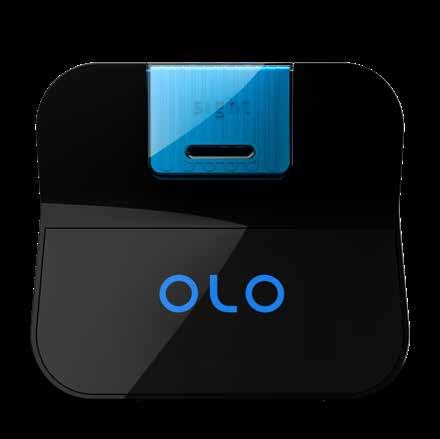
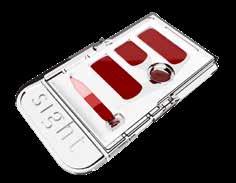
State-of-the-Art Benchtop CBC Analyzer
OLO® by Sight Diagnostics® is a state-of-the-art benchtop CBC analyzer that leverages AI, spectroscopy, and digital fluorescent microscopy to provide lab-grade results through full blood sample digitization. OLO offers 19 CBC parameters, including a 5-part white blood cell differential and 14 distinct flags. It handles venous and capillary blood samples with a minimum of 27 µL, and is suitable for children as young as three months. OLO’s unique cartridge-based technology, free from liquid reagents, and its internal controls offer easy maintenance, roomtemperature storage, reduced operational overhead, and IQCP- eligibility.
OLO is FDA 510(k) cleared for use in moderately complex laboratories. For full indications for use and safety information, please refer to the Quality and Compliance page at www.sighdx.com.
View Brochures, Videos & More at POR.io Enter Number 3901 in the Search Area
6 16 28 32
5 Factors to Consider:
When Choosing a Hematology Analyzer for Your Moderately Complex Lab
Molecular Diagnostics for the Future
The ideal introductory molecular product for facilities yet to adopt molecular technology
Men’s Health: Preventing a Health Crisis
The average U.S. male lives to 76 years old compared to the average female life expectancy of 81
Four Seasons Resort Orlando at Walt Disney World Resort 3901
MDescapes: If the Glass Slipper Fit

Electrolytes can now run just like other chemistries. Avoid extra cost and maintenance associated with ISE.



5 FACTORS TO CONSIDER
WHEN CHOOSING A HEMATOLOGY ANALYZER FOR YOUR
MODERATELY COMPLEX LAB
BY NITSAN MAAYAN-RABINOWICH, CHIEF STRATEGY OFFICER, SIGHT DIAGNOSTICSWhether you’re planning to establish a moderately complex Physician Office Lab, or you’re an experienced practitioner eyeing a new Complete Blood Count (CBC) analyzer for your existing facility, understanding the key factors in selecting the right equipment is paramount. This article is designed to help you navigate the selection process of a CBC analyzer that will align seamlessly with your clinical demands and operational workflows, enabling you to provide superior patient care.
1- Clinical Performance
When integrating a new laboratory device, the top priority is to ensure that it delivers accurate results and meets your specific clinical requirements. While many CBC analyzers might provide precise readings, inferior performances often manifest through a higher rate of invalidations and suppressed results. If results are absent or reported with measurement issues (flagged), local lab policies typically mandate further reflex testing or a smear review. This not only hampers healthcare providers’ ability to make swift clinical decisions, but may also involve sending samples to an external laboratory, which is both costly and time-consuming. Crucially, the lag in verifying lab results delays treatment and heightens patient anxiety. When a CBC analyzer consistently falls short in delivering actionable results (results devoid of invalidations or suppressions), it defeats the purpose of having an on-site lab solution, intended to offer rapid quality care directly at the point of service. Several factors affect the rate of invalidated results, such as the device’s analytical range (reportable and display), its precision in flagging results, the extent of the abnormality flagging menu, and the detail in its white blood cell differential.
So, how does it work, and why are these factors crucial in affecting a CBC analyzer’s effectiveness in producing actionable results?
Analytical measuring range - this refers to the range of values that the CBC device can accurately measure and report. When a CBC parameter level is outside the analytical range of the analyzer, the result might be suppressed or marked as invalidated. This is a key indicator of the device’s analytical capabilities. The challenge with the CBC often lies in accurately detecting lower levels of counts, which are difficult to process, yet crucial to measure, given that such conditions typically involve higher risk and require swift decision-making. Given that CBC analyzers offer varying reportable ranges, dedicating time to researching and determining which device best aligns with your clinical needs and patient demographics is crucial. This approach can markedly decrease the need to send out tests for external analysis.
Flagging Sensitivity and Specificity: Flagging sensitivity in CBC analyzers refers to the device’s proficiency in identifying and raising a flag to any hematology abnormalities or measurement discrepancies. Conversely, Flagging Specificity refers to the analyzer’s ability to correctly identify and flag abnormal results without generating false alarms. The importance of flagging sensitivity is widely acknowledged; it ensures that no significant measurement mishaps or essential clinical inputs slip through the cracks. That said, flagging specificity is crucial as well, as it directly influences workflow efficiency. Inversely, as the flagging specificity rate drops, the incidence of false positives — where normal tests are inaccurately labeled as abnormal—increases. This not only leads to unnecessary reflex testing or manual smears, but also causes delays in treatment and detracts from the cost-effectiveness of the device. For example, a
CBC analyzer with a 70% flagging specificity suggests that in 30% of the cases, the analyzer will erroneously signal abnormal results (false positives). This indicates that in 30% of the cases, reflex testing could be avoided. The good news is, that thanks to modern advancements, the market now offers CBC analyzers with a flagging specificity of over 90%, which can significantly streamline your operations.
The Depth and Specificity of a CBC’s Flagging Menu refers to the number of specific flags for distinct CBC abnormalities such as immature granulocytes, nRBCs, atypical lymphocytes, platelets clumps, blasts, and others. A rich flagging menu enhances the analyzer’s ability to identify distinct abnormalities more accurately. The precise identification minimizes the risk of results being invalidated or suppressed by providing clear insights into potential abnormalities rather than broadly flagging results as abnormal. In contrast, analyzers with limited or generic flagging options might lead to the unnecessary manual examination of samples that are not actually abnormal. A rich flagging menu mitigates this by accurately identifying borderline or slightly abnormal results, which may not require further analysis. The bottom line is, when selecting a CBC analyzer for your practice, the number and variety of specificity of abnormality flags it offers should be a key consideration - the more, the merrier.
The number of white blood cell (WBC) differentials (3 vs. 5 diff) in a CBC analyzer refers to the number of different types of white blood cells the analyzer can identify and enumerate separately. Analyzers with a 5-diff capability offer more comprehensive and nuanced results by distinguishing among a greater variety of white blood cells, thus providing clinicians with deeper insights for accurate diagnoses, differentiating infections from blood disorders, and formulating effective treatment strategies. In contrast, analyzers with limited differential capabilities (3-diff) might lead to incomplete data, requiring additional tests or referrals to specialized external labs, thereby increasing expenses and delaying critical care. While 3-diff analyzers may still be useful for many standard blood count purposes, their limitations in terms of specificity and sensitivity can result in more frequent invalidations and suppressed results compared to the more advanced 5-diff analyzers. When an abnormality occurs in one of the cell types grouped into one category (neutrophils, eosinophils, and basophils), this grouping can lead to invalidations if there are abnormalities in one of these subtypes, as the analyzer cannot specify which type is affected. 3-diff CBC analyzers are estimated to report at least 50% more of the total number of samples generating a suspicious flag than their 5-diff counterparts, ultimately reducing laboratory time and costs related to sample processing and shipping¹ .
To learn more about a specific CBC analyzers’ clinical performances and features, we recommend you read their latest FDA-510(k) summaries and marketing brochures, or simply ask your sales representative for this information. Additionally, you can find detailed insights in the device’s Instructions For Use or Operators Manual.
2. Patient Age Applicability
On average, children under the age of one visit their primary care physician four times a year, which is 2 to 4 times more than any other pediatric age group.² Fever ranks as a top reason for medical consultation, while for babies under three months, and febrile, the standard recommendation is an in-hospital observation.3 For children older than three months, it’s typically recommended that they initially visit a primary care physician before heading to the emergency department.4 A CBC with a differential, or at a minimum a WBC count, is advised for children with fever.5 Moreover, the American Academy of Pediatrics (AAP) recommends CBC screening for anemia in the 9 to 12 months age bracket,6 as adequate iron stores are critical for normal cognitive development. Therefore, if you provide or plan to provide care to pediatric patients, ensuring your on-site CBC device is suitable for children aged three months and older is essential.
3. Blood Collection Method Options
For those treating pediatric patients, it’s widely recognized that up to a certain age, using capillary blood for a CBC test is far more convenient than a venous draw. The capillary method is easier to collect, requires a smaller blood volume, and is less intimidating and painful for both the patient and their caregiver. Capillary sampling is also an appealing option for populations where conventional sampling methods face difficulties, such as elderly, psychiatric, and oncology patients.
Until recently, finding a tabletop CBC analyzer that was FDA-cleared for capillary blood testing was nearly impossible. Nowadays, there are several new technologies that are FDA-cleared for CBC capillary blood testing via a tube or directly from the finger.
4. Eligibility for Individualized Quality Control Plan (IQCP)
If your facility already operates laboratory equipment, you’re probably well-versed in the rigorous quality control and result verification procedures mandated by the Clinical Laboratory Improvement Amendments (CLIA). Typically, you probably spend considerable daily time on quality control procedures, documentation, results review, and related tasks. Imagine reallocating this time towards activities that generate more value or avoiding the inconvenience of informing a patient that their test cannot be conducted because the device is undergoing its daily quality control. The good news is that this is now achievable for a select number of CBC analyzers through the implementation of an Individualized Quality Control Plan (IQCP).7 IQCP is a tailor-made quality control strategy endorsed by CLIA for devices with advanced and robust internal controls that ensure consistent performance and calibration over time. By implementing an IQCP, you can significantly cut down the daily QC procedures from once a day to a few times a month, saving time, money, and energy while still adhering to compliance measures. Since this option is available with only a limited number of devices, the best way to determine whether a CBC device is eligible for IQCP is to ask your sales representative.
Device Cleaning and Maintenance
Have you ever wondered how much time you and your team dedicate to cleaning and maintaining your CBC analyzer? From daily startup and shutdown cleaning through weekly flush tubing, reagent replacement, and aperture cleaning to monthly tubing replacement, not to mention regular internal component cleanings and preventative maintenance checks, these tasks, while essential for the accurate operation of liquid reagent-based CBC analyzers, are notably time-consuming and exhausting.
Fortunately, cartridge-based CBC analyzers, free from liquid reagents, present a solution to these exhaustive procedures. This new generation of devices utilizes single-use, disposable test kits containing a cartridge and everything required to perform the CBC test. Unlike liquid reagents, these kits have a long shelf life and do not require special storage conditions. The device itself contains no tubes or reagents, so traditional cleaning or maintenance virtually disappears, freeing up your team to focus on what matters most — delivering quality, efficient patient care without the burden of non-essential tasks.
Summary
Choosing the right CBC analyzer involves a careful evaluation beyond just clinical performance, such as analytical precision, flagging specificity and menu richness, and WBC differential count. It’s equally important to consider operational aspects, like the ease of maintenance, IQCP eligibility, adaptability to various age groups, and blood collection techniques. The objective is to select a device that not only ensures accurate and timely results but also seamlessly integrates into your practice’s workflow, thereby elevating the standard of care provided.
References:
1. “Hematology analyzers: 3-part or 5-part, that is the question”, Boule.com, 2019
2. “Primary Care in the United States: A Chartbook of Facts and Statistics”, Robert Graham Center, February 2021
3. ”Fever in children: pearls and pitfalls”, Barbi E, Marzuillo P, Neri E, Naviglio S, Krauss BS, , Pubmed Central, September 2017
4. “A fever is rarely a reason to go to the hospital — here’s what to do if you or your child has a fever”, Business Insider, December 2020
5. “Fever Without a Focus Workup”, Muhammad Waseem, Medscape, June 2023
6. “Clinical Report—Diagnosis and Prevention of Iron Deficiency and Iron-Deficiency Anemia in Infants and Young Children (0–3 Years of Age)”, Robert D. Baker, MD, PhD, Frank R. Greer, MD, and THE COMMITTEE ON NUTRITION ,American Academy of Pediatrics, 2010
7. Individualized Quality Control Plan (IQCP) | CDC



CHEMISTRY
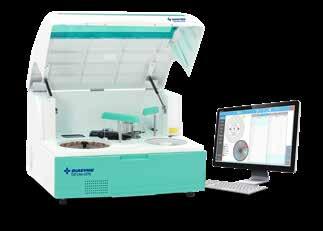
DIAZYME DZ-LITE™ C270 BENCHTOP GENERAL/SPECIAL CHEMISTRIES + DRUG SCREENS
From Carolina Liquid Chemistries
A fully-automated, open system, benchtop clinical chemistry analyzer with throughput up to 270 tests/hour, 36 reagent positions, and 30 sample positions. It features a menu of over 60 CLIA moderate complexity assays, including cancer markers, cardiovascular markers, coagulation markers, diabetic markers, inflammatory markers, liver markers, renal/pancreatic markers, sepsis markers, vitamin markers, photometric electrolytes, and drugs of abuse. To learn more, visit https://www.carolinachemistries.com/products/dz-lite-c270-benchtop-chemistry-analyzer/.
View Brochures, Videos & More at POR.io
Enter Number 3905 in the Search Area
FULL COMPLEMENT OF CLIA-WAIVED
BLOOD CHEMISTRY TESTS PICCOLO XPRESS® CHEMISTRY ANALYZER
From Abbott Point of Care
The Piccolo Xpress Chemistry Analyzer provides physician offices with lab-accurate results for a broad range of CLIAwaived general chemistry tests, including metabolic panels, lipids, live, and kidney function, and more with just 100 microliters of blood. Easy to use, the PIccolo Xpress provides results during a patient’s visit, accelerating treatment decisions, increasing efficiency, and supporting patient satisfaction. Automated quality control on every test helps ensure accuracy.
View Brochures, Videos & More at POR.io
Enter Number 3906 in the Search Area


Full Complement of Piccolo Xpress® Chemistry
3906
The Piccolo Xpress lab-accurate results tests, including metabolic with just 100 microliters results during a patient’s efficiency, and supporting every test helps ensure
EASYRA® BENCHTOP CHEMISTRIES + DRUGS
From Carolina Liquid Chemistries
When starting a lab, look no further. With a CLIA moderately complex menu of 35 general chemistries and 14 urine drug screens, the EasyRA is well-suited for oncology, rheumatology, and multi-specialty practices needing a benchtop clinical chemistry analyzer. The EasyRA offers photometric throughput of 240+ tests/hr (up to 480 tests/hr with ISE) and STAT samples in under 8 minutes. This all-in-one system is easy to learn and easy to operate.
View Brochures, Videos & More at POR.io
Enter Number 3907 in the Search Area
FOR THE TREATMENT OF ADULT PATIENTS WITH MODERATELY TO SEVERELY ACTIVE CROHN’S DISEASE (CD) OR ULCERATIVE COLITIS (UC).


START WITH STELAR A® (ustekinumab)
INDICATIONS
STELARA ® (ustekinumab) is indicated for the treatment of adult patients with moderately to severely active Crohn’s disease. STELARA ® is indicated for the treatment of adult patients with moderately to severely active ulcerative colitis.
SELECTED IMPORTANT SAFETY INFORMATION
STELARA ® is contraindicated in patients with clinically signi cant hypersensitivity to ustekinumab or excipients. Serious adverse reactions have been reported in STELARA ®-treated patients, including bacterial, mycobacterial, fungal, and viral infections, malignancies, hypersensitivity reactions, Posterior Reversible Encephalopathy Syndrome (PRES), and noninfectious pneumonia. STELARA ® should not be given to patients with any clinically important active infection. Patients should be evaluated for tuberculosis prior to initiating treatment with STELARA ®. Live vaccines should not be given to patients receiving STELARA ®. If PRES is suspected or if noninfectious pneumonia is con rmed, discontinue STELARA ® .
Please see Important Safety Information and Brief Summary of full Prescribing Information for STELARA® starting on the reverse side of this page.
IMPORTANT SAFETY INFORMATION
STELARA ® (ustekinumab) is contraindicated in patients with clinically signi cant hypersensitivity to ustekinumab or to any of the excipients.
Infections
STELARA ® may increase the risk of infections and reactivation of latent infections. Serious bacterial, mycobacterial, fungal, and viral infections requiring hospitalization or otherwise clinically signi cant infections were reported. In patients with psoriasis, these included diverticulitis, cellulitis, pneumonia, appendicitis, cholecystitis, sepsis, osteomyelitis, viral infections, gastroenteritis, and urinary tract infections. In patients with psoriatic arthritis, this included cholecystitis. In patients with Crohn’s disease, these included anal abscess, gastroenteritis, ophthalmic herpes zoster, pneumonia, and Listeria meningitis. In patients with ulcerative colitis, these included gastroenteritis, ophthalmic herpes zoster, pneumonia, and listeriosis.
Treatment with STELARA ® should not be initiated in patients with a clinically important active infection until the infection resolves or is adequately treated. Consider the risks and bene ts of treatment prior to initiating use of STELARA ® in patients with a chronic infection or a history of recurrent infection. Instruct patients to seek medical advice if signs or symptoms suggestive of an infection occur while on treatment with STELARA ® and consider discontinuing STELARA ® for serious or clinically signi cant infections until the infection resolves or is adequately treated.
Theoretical Risk for Vulnerability to Particular Infections
Individuals genetically de cient in IL-12/IL-23 are particularly vulnerable to disseminated infections from mycobacteria, Salmonella, and Bacillus Calmette-Guerin (BCG) vaccinations. Serious infections and fatal outcomes have been reported in such patients. It is not known whether patients with pharmacologic blockade of IL-12/IL-23 from treatment with STELARA ® may be susceptible to these types of infections. Appropriate diagnostic testing should be considered (eg, tissue culture, stool culture) as dictated by clinical circumstances.
Pre-Treatment Evaluation of Tuberculosis (TB)
Evaluate patients for TB prior to initiating treatment with STELARA ®. Do not administer STELARA ® to patients with active tuberculosis infection. Initiate treatment of latent TB before administering STELARA ®. Closely monitor patients receiving STELARA ® for signs and symptoms of active TB during and after treatment.
Malignancies
STELARA ® is an immunosuppressant and may increase the risk of malignancy. Malignancies were reported among patients who received STELARA ® in clinical studies. The safety of STELARA ® has not been evaluated in patients who have a history of malignancy or who have a known malignancy. There have been reports of the rapid appearance of multiple cutaneous squamous cell carcinomas in patients receiving STELARA ® who had risk factors for developing non-melanoma skin cancer (NMSC). All patients receiving STELARA ®, especially those >60 years or those with a history of PUVA or prolonged immunosuppressant treatment, should be monitored for the appearance of NMSC.
Hypersensitivity Reactions
Hypersensitivity reactions, including anaphylaxis and angioedema, have been reported with STELARA ®. If an anaphylactic or other clinically signi cant hypersensitivity reaction occurs, institute appropriate therapy and discontinue STELARA ® Posterior Reversible Encephalopathy Syndrome (PRES)
Two cases of posterior reversible encephalopathy syndrome (PRES), also known as Reversible Posterior Leukoencephalopathy Syndrome (RPLS), were reported in clinical trials. Cases have also been reported in postmarketing experience in patients with psoriasis, psoriatic arthritis and Crohn’s disease. Clinical presentation included headaches, seizures, confusion, visual disturbances, and imaging changes consistent with PRES a few days to several months after ustekinumab initiation. A few cases reported latency of a year or longer. Patients recovered with supportive care following withdrawal of ustekinumab.
Monitor all patients treated with STELARA ® for signs and symptoms of PRES. If PRES is suspected, promptly administer appropriate treatment and discontinue STELARA ® Immunizations
Prior to initiating therapy with STELARA ®, patients should receive all age-appropriate immunizations recommended by current guidelines. Patients being treated with STELARA ® should not receive live vaccines. BCG vaccines should not be given during treatment or within one year of initiating or discontinuing STELARA ®. Exercise caution when administering live vaccines to household contacts of STELARA ® patients, as shedding and subsequent transmission to STELARA ® patients may occur. Non-live vaccinations received during a course of STELARA ® may not elicit an immune response suf cient to prevent disease.
Concomitant Therapies
The safety of STELARA ® in combination with other biologic immunosuppressive agents or phototherapy was not evaluated in clinical studies of psoriasis. Ultraviolet-induced skin cancers developed earlier and more frequently in mice. In psoriasis studies, the relevance of ndings in mouse models for malignancy risk in humans is unknown. In psoriatic arthritis studies, concomitant methotrexate use did not appear to in uence the safety or ef cacy of STELARA ®. In Crohn’s disease and ulcerative colitis induction studies, concomitant use of 6-mercaptopurine, azathioprine, methotrexate, and corticosteroids did not appear to in uence the overall safety or ef cacy of STELARA ®
Noninfectious Pneumonia
Cases of interstitial pneumonia, eosinophilic pneumonia, and cryptogenic organizing pneumonia have been reported during post-approval use of STELARA ®. Clinical presentations included cough, dyspnea, and interstitial in ltrates following one to three doses. Serious outcomes have included respiratory failure and prolonged hospitalization. Patients improved with discontinuation of therapy and, in certain cases, administration of corticosteroids. If diagnosis is con rmed, discontinue STELARA ® and institute appropriate treatment.
Allergen Immunotherapy
STELARA ® may decrease the protective effect of allergen immunotherapy (decrease tolerance) which may increase the risk of an allergic reaction to a dose of allergen immunotherapy. Therefore, caution should be exercised in patients receiving or who have received allergen immunotherapy, particularly for anaphylaxis.
Most Common Adverse Reactions
The most common adverse reactions (≥3% and higher than that with placebo) in adults from psoriasis clinical studies for STELARA ® 45 mg, STELARA ® 90 mg, or placebo were: nasopharyngitis (8%, 7%, 8%), upper respiratory tract infection (5%, 4%, 5%), headache (5%, 5%, 3%), and fatigue (3%, 3%, 2%), respectively. The safety pro le in pediatric patients with plaque psoriasis was similar to that of adults with plaque psoriasis. In psoriatic arthritis (PsA) studies, a higher incidence of arthralgia and nausea was observed in patients treated with STELARA ® when compared with placebo (3% vs 1% for both). In Crohn’s disease induction studies, common adverse reactions (3% or more of patients treated with STELARA ® and higher than placebo) reported through Week 8 for STELARA ® 6 mg/kg intravenous single infusion or placebo included: vomiting (4% vs 3%). In the Crohn’s disease maintenance study, common adverse reactions (3% or more of patients treated with STELARA ® and higher than placebo) reported through Week 44 for STELARA ® 90 mg subcutaneous injection or placebo were: nasopharyngitis (11% vs 8%), injection site erythema (5% vs 0%), vulvovaginal candidiasis/mycotic infection (5% vs 1%), bronchitis (5% vs 3%), pruritus (4% vs 2%), urinary tract infection (4% vs 2%) and sinusitis (3% vs 2%). In the ulcerative colitis induction study, common adverse reactions (3% or more of patients treated with STELARA ® and higher than placebo) reported through Week 8 for STELARA ® 6 mg/kg intravenous single infusion or placebo included: nasopharyngitis (7% vs 4%). In the ulcerative colitis maintenance study, common adverse reactions (3% or more of patients treated with STELARA ® and higher than placebo) reported through Week 44 for STELARA ® 90 mg subcutaneous injection or placebo included: nasopharyngitis (24% vs 20%), headache (10% vs 4%), abdominal pain (7% vs 3%), in uenza (6% vs 5%), fever (5% vs 4%), diarrhea (4% vs 1%), sinusitis (4% vs 1%), fatigue (4% vs 2%), and nausea (3% vs 2%).
Please see full Prescribing Information and Medication Guide for STELARA ® at stelarahcp.com/ibd. Provide the Medication Guide to your patients and encourage discussion.
cp-124933v5
Brief Summary of Prescribing Information for STELARA® (ustekinumab)
STELARA® Injection, for subcutaneous use
See package insert for Full Prescribing Information
INDICATIONS AND USAGE: Psoriasis (Ps): STELARA® is indicated for the treatment of patients 6 years or older with moderate to severe plaque psoriasis who are candidates for phototherapy or systemic therapy. Psoriatic Arthritis (PsA): STELARA® is indicated for the treatment of patients 6 years or older with active psoriatic arthritis. Crohn’s Disease (CD): STELARA® is indicated for the treatment of adult patients with moderately to severely active Crohn’s disease. Ulcerative Colitis: STELARA® is indicated for the treatment of adult patients with moderately to severely active ulcerative colitis. CONTRAINDICATIONS: STELARA® is contraindicated in patients with clinically significant hypersensitivity to ustekinumab or to any of the excipients [see Warnings and Precautions]. WARNINGS AND PRECAUTIONS: Infections: STELARA® may increase the risk of infections and reactivation of latent infections. Serious bacterial, mycobacterial, fungal, and viral infections were observed in patients receiving STELARA® [see Adverse Reactions]. Serious infections requiring hospitalization, or otherwise clinically significant infections, reported in clinical studies included the following: • Psoriasis: diverticulitis, cellulitis, pneumonia, appendicitis, cholecystitis, sepsis, osteomyelitis, viral infections, gastroenteritis and urinary tract infections. • Psoriatic arthritis: cholecystitis. • Crohn’s disease: anal abscess, gastroenteritis, ophthalmic herpes zoster, pneumonia, and listeria meningitis. • Ulcerative colitis: gastroenteritis, ophthalmic herpes zoster, pneumonia, and listeriosis. Treatment with STELARA® should not be initiated in patients with any clinically important active infection until the infection resolves or is adequately treated. Consider the risks and benefits of treatment prior to initiating use of STELARA® in patients with a chronic infection or a history of recurrent infection. Instruct patients to seek medical advice if signs or symptoms suggestive of an infection occur while on treatment with STELARA® and consider discontinuing STELARA® for serious or clinically significant infections until the infection resolves or is adequately treated. Theoretical Risk for Vulnerability to Particular Infections: Individuals genetically deficient in IL-12/IL-23 are particularly vulnerable to disseminated infections from mycobacteria (including nontuberculous, environmental mycobacteria), salmonella (including nontyphi strains), and Bacillus Calmette-Guerin (BCG) vaccinations. Serious infections and fatal outcomes have been reported in such patients. It is not known whether patients with pharmacologic blockade of IL-12/IL-23 from treatment with STELARA® may be susceptible to these types of infections. Appropriate diagnostic testing should be considered, e.g., tissue culture, stool culture, as dictated by clinical circumstances. Pre-treatment Evaluation for Tuberculosis: Evaluate patients for tuberculosis infection prior to initiating treatment with STELARA®. Do not administer STELARA® to patients with active tuberculosis infection. Initiate treatment of latent tuberculosis prior to administering STELARA®. Consider anti-tuberculosis therapy prior to initiation of STELARA® in patients with a past history of latent or active tuberculosis in whom an adequate course of treatment cannot be confirmed. Closely monitor patients receiving STELARA® for signs and symptoms of active tuberculosis during and after treatment. Malignancies: STELARA® is an immunosuppressant and may increase the risk of malignancy. Malignancies were reported among subjects who received STELARA® in clinical studies [see Adverse Reactions]. In rodent models, inhibition of IL-12/IL-23p40 increased the risk of malignancy [see Nonclinical Toxicology (13) in Full Prescribing Information]. The safety of STELARA® has not been evaluated in patients who have a history of malignancy or who have a known malignancy. There have been post-marketing reports of the rapid appearance of multiple cutaneous squamous cell carcinomas in patients receiving STELARA® who had pre-existing risk factors for developing non-melanoma skin cancer. All patients receiving STELARA® should be monitored for the appearance of non-melanoma skin cancer. Patients greater than 60 years of age, those with a medical history of prolonged immunosuppressant therapy and those with a history of PUVA treatment should be followed closely [see Adverse Reactions]. Hypersensitivity Reactions: Hypersensitivity reactions, including anaphylaxis and angioedema, have been reported with STELARA® [see Adverse Reactions]. If an anaphylactic or other clinically significant hypersensitivity reaction occurs, institute appropriate therapy and discontinue STELARA® Posterior Reversible Encephalopathy Syndrome (PRES): Two cases of posterior reversible encephalopathy syndrome (PRES), also known as Reversible Posterior Leukoencephalopathy Syndrome (RPLS), were reported in clinical trials. Cases have also been reported in postmarketing experience in patients with psoriasis, psoriatic arthritis and Crohn’s disease. Clinical presentation included headaches, seizures, confusion, visual disturbances, and imaging changes consistent with PRES a few days to several months after ustekinumab initiation. A few cases reported latency of a year or longer. Patients recovered with supportive care following withdrawal of ustekinumab. Monitor all patients treated with STELARA® for signs and symptoms of PRES. If PRES is suspected, promptly administer appropriate treatment and discontinue STELARA® Immunizations: Prior to initiating therapy with STELARA®, patients should receive all age-appropriate immunizations as recommended
by current immunization guidelines. Patients being treated with STELARA® should not receive live vaccines. BCG vaccines should not be given during treatment with STELARA® or for one year prior to initiating treatment or one year following discontinuation of treatment. Caution is advised when administering live vaccines to household contacts of patients receiving STELARA® because of the potential risk for shedding from the household contact and transmission to patient. Non-live vaccinations received during a course of STELARA® may not elicit an immune response sufficient to prevent disease. Concomitant Therapies: In clinical studies of psoriasis the safety of STELARA® in combination with other biologic immunosuppressive agents or phototherapy was not evaluated. Ultraviolet-induced skin cancers developed earlier and more frequently in mice genetically manipulated to be deficient in both IL-12 and IL-23 or IL-12 alone [see Concomitant Therapies, Nonclinical Toxicology (13.1) in Full Prescribing Information]. Noninfectious Pneumonia: Cases of interstitial pneumonia, eosinophilic pneumonia and cryptogenic organizing pneumonia have been reported during post-approval use of STELARA®. Clinical presentations included cough, dyspnea, and interstitial infiltrates following one to three doses. Serious outcomes have included respiratory failure and prolonged hospitalization. Patients improved with discontinuation of therapy and in certain cases administration of corticosteroids. If diagnosis is confirmed, discontinue STELARA® and institute appropriate treatment [see Postmarketing Experience]. ADVERSE REACTIONS: The following serious adverse reactions are discussed elsewhere in the label: • Infections [see Warnings and Precautions] • Malignancies [see Warnings and Precautions] • Hypersensitivity Reactions [see Warnings and Precautions] • Posterior Reversible Encephalopathy Syndrome (PRES) [see Warnings and Precautions] Clinical Trials Experience: Because clinical trials are conducted under widely varying conditions, adverse reaction rates observed in the clinical trials of a drug cannot be directly compared to rates in the clinical trials of another drug and may not reflect the rates observed in practice. Adult Subjects with Plaque Psoriasis: The safety data reflect exposure to STELARA® in 3117 adult psoriasis subjects, including 2414 exposed for at least 6 months, 1855 exposed for at least one year, 1653 exposed for at least two years, 1569 exposed for at least three years, 1482 exposed for at least four years and 838 exposed for at least five years. Table 1 summarizes the adverse reactions that occurred at a rate of at least 1% and at a higher rate in the STELARA® groups than the placebo group during the placebo-controlled period of Ps STUDY 1 and Ps STUDY 2 [see Clinical Studies (14) in Full Prescribing Information].
Table 1: Adverse Reactions Reported by ≥1% of Subjects through Week 12 in Ps STUDY 1 and Ps STUDY 2
Adverse reactions that occurred at rates less than 1% in the controlled period of Ps STUDIES 1 and 2 through week 12 included: cellulitis, herpes zoster, diverticulitis and certain injection site reactions (pain, swelling, pruritus, induration, hemorrhage, bruising, and irritation). One case of PRES occurred during adult plaque psoriasis clinical studies [see Warnings and Precautions]. Infections: In the placebo-controlled period of clinical studies of psoriasis subjects (average follow-up of 12.6 weeks for placebo-treated subjects and 13.4 weeks for STELARA®treated subjects), 27% of STELARA®-treated subjects reported infections (1.39 per subject-year of follow-up) compared with 24% of placebotreated subjects (1.21 per subject-year of follow-up). Serious infections occurred in 0.3% of STELARA®-treated subjects (0.01 per subject-year of follow-up) and in 0.4% of placebo-treated subjects (0.02 per subjectyear of follow-up) [see Warnings and Precautions]. In the controlled and non-controlled portions of psoriasis clinical studies (median followup of 3.2 years), representing 8998 subject-years of exposure, 72.3% of STELARA®-treated subjects reported infections (0.87 per subjectyears of follow-up). Serious infections were reported in 2.8% of subjects (0.01 per subject-years of follow-up). Malignancies: In the controlled and
non-controlled portions of psoriasis clinical studies (median follow-up of 3.2 years, representing 8998 subject-years of exposure), 1.7% of STELARA®treated subjects reported malignancies excluding non-melanoma skin cancers (0.60 per hundred subject-years of follow-up). Non-melanoma skin cancer was reported in 1.5% of STELARA®-treated subjects (0.52 per hundred subject-years of follow-up) [see Warnings and Precautions]. The most frequently observed malignancies other than non-melanoma skin cancer during the clinical studies were: prostate, melanoma, colorectal and breast. Malignancies other than non-melanoma skin cancer in STELARA®-treated patients during the controlled and uncontrolled portions of studies were similar in type and number to what would be expected in the general U.S. population according to the SEER database (adjusted for age, gender and race).1 Pediatric Subjects with Plaque Psoriasis: The safety of STELARA® was assessed in two studies of pediatric subjects with moderate to severe plaque psoriasis. Ps STUDY 3 evaluated safety for up to 60 weeks in 110 adolescents (12 to 17 years old). Ps STUDY 4 evaluated safety for up to 56 weeks in 44 children (6 to 11 years old). The safety profile in pediatric subjects was similar to the safety profile from studies in adults with plaque psoriasis. Psoriatic Arthritis: The safety of STELARA® was assessed in 927 subjects in two randomized, double-blind, placebocontrolled studies in adults with active psoriatic arthritis (PsA). The overall safety profile of STELARA® in subjects with PsA was consistent with the safety profile seen in adult psoriasis clinical studies. A higher incidence of arthralgia, nausea, and dental infections was observed in STELARA®treated subjects when compared with placebo-treated subjects (3% vs. 1% for arthralgia and 3% vs. 1% for nausea; 1% vs. 0.6% for dental infections) in the placebo-controlled portions of the PsA clinical studies. Crohn’s Disease: The safety of STELARA® was assessed in 1407 subjects with moderately to severely active Crohn’s disease (Crohn’s Disease Activity Index [CDAI] greater than or equal to 220 and less than or equal to 450) in three randomized, double-blind, placebo-controlled, parallel-group, multicenter studies. These 1407 subjects included 40 subjects who received a prior investigational intravenous ustekinumab formulation but were not included in the efficacy analyses. In Studies CD-1 and CD-2 there were 470 subjects who received STELARA® 6 mg/kg as a weight-based single intravenous induction dose and 466 who received placebo [see Dosage and Administration (2.3) in Full Prescribing Information]. Subjects who were responders in either Study CD-1 or CD-2 were randomized to receive a subcutaneous maintenance regimen of either 90 mg STELARA® every 8 weeks, or placebo for 44 weeks in Study CD-3. Subjects in these 3 studies may have received other concomitant therapies including aminosalicylates, immunomodulatory agents [azathioprine (AZA), 6-mercaptopurine (6-MP), methotrexate (MTX)], oral corticosteroids (prednisone or budesonide), and/or antibiotics for their Crohn’s disease [see Clinical Studies (14.4) in Full Prescribing Information]. The overall safety profile of STELARA® was consistent with the safety profile seen in the adult psoriasis and psoriatic arthritis clinical studies. Common adverse reactions in Studies CD-1 and CD-2 and in Study CD-3 are listed in Tables 2 and 3, respectively.
Table 2: Common adverse reactions through Week 8 in Studies CD-1 and CD-2 occurring in ≥3% of STELARA®-treated subjects and higher than placebo
Placebo N=466
STELARA® 6 mg/kg single intravenous induction dose N=470
Vomiting 3% 4%
Other less common adverse reactions reported in subjects in Studies CD-1 and CD-2 included asthenia (1% vs 0.4%), acne (1% vs 0.4%), and pruritus (2% vs 0.4%).
Table 3: Common adverse reactions through Week 44 in Study CD-3 occurring in ≥3% of STELARA®-treated subjects and higher than placebo
Placebo N=133
STELARA® 90 mg subcutaneous maintenance dose every 8 weeks N=131
Infections: In patients with Crohn’s disease, serious or other clinically significant infections included anal abscess, gastroenteritis, and pneumonia. In addition, listeria meningitis and ophthalmic herpes zoster were reported in one patient each [see Warnings and Precautions]. Malignancies: With up to one year of treatment in the Crohn’s disease clinical studies, 0.2% of STELARA®-treated subjects (0.36 events per hundred patient-years) and 0.2% of placebo-treated subjects (0.58 events per hundred patient-years) developed non-melanoma skin cancer. Malignancies other than non-melanoma skin cancers occurred in 0.2% of STELARA®-treated subjects (0.27 events per hundred patient-years) and in none of the placebo-treated subjects. Hypersensitivity Reactions Including Anaphylaxis: In CD studies, two patients reported hypersensitivity reactions following STELARA® administration. One patient experienced signs and symptoms consistent with anaphylaxis (tightness of the throat, shortness of breath, and flushing) after a single subcutaneous administration (0.1% of patients receiving subcutaneous STELARA®). In addition, one patient experienced signs and symptoms consistent with or related to a hypersensitivity reaction (chest discomfort, flushing, urticaria, and increased body temperature) after the initial intravenous STELARA® dose (0.08% of patients receiving intravenous STELARA®). These patients were treated with oral antihistamines or corticosteroids and in both cases symptoms resolved within an hour. Ulcerative Colitis: The safety of STELARA® was evaluated in two randomized, double-blind, placebocontrolled clinical studies (UC-1 [IV induction] and UC-2 [SC maintenance]) in 960 adult subjects with moderately to severely active ulcerative colitis [see Clinical Studies (14.5) in Full Prescribing Information]. The overall safety profile of STELARA® in patients with ulcerative colitis was consistent with the safety profile seen across all approved indications. Adverse reactions reported in at least 3% of STELARA®-treated subjects and at a higher rate than placebo were: • Induction (UC-1): nasopharyngitis (7% vs 4%). • Maintenance (UC-2): nasopharyngitis (24% vs 20%), headache (10% vs 4%), abdominal pain (7% vs 3%), influenza (6% vs 5%), fever (5% vs. 4%), diarrhea (4% vs 1%), sinusitis (4% vs 1%), fatigue (4% vs 2%), and nausea (3% vs 2%). Infections: In patients with ulcerative colitis, serious or other clinically significant infections included gastroenteritis and pneumonia. In addition, listeriosis and ophthalmic herpes zoster were reported in one patient each [see Warnings and Precautions]. Malignancies: With up to one year of treatment in the ulcerative colitis clinical studies, 0.4% of STELARA®treated subjects (0.48 events per hundred patient-years) and 0.0% of placebo-treated subjects (0.00 events per hundred patient-years) developed non-melanoma skin cancer. Malignancies other than non-melanoma skin cancers occurred in 0.5% of STELARA®-treated subjects (0.64 events per hundred patient-years) and 0.2% of placebo-treated subjects (0.40 events per hundred patient-years). Immunogenicity: As with all therapeutic proteins, there is potential for immunogenicity. The detection of antibody formation is highly dependent on the sensitivity and specificity of the assay. Additionally, the observed incidence of antibody (including neutralizing antibody) positivity in an assay may be influenced by several factors, including assay methodology, sample handling, timing of sample collection, concomitant medications and underlying disease. For these reasons, comparison of the incidence of antibodies to ustekinumab in the studies described below with the incidence of antibodies to other products may be misleading.Approximately 6 to 12.4% of subjects treated with STELARA® in psoriasis and psoriatic arthritis clinical studies developed antibodies to ustekinumab, which were generally low-titer. In psoriasis clinical studies, antibodies to ustekinumab were associated with reduced or undetectable serum ustekinumab concentrations and reduced efficacy. In psoriasis studies, the majority of subjects who were positive for antibodies to ustekinumab had neutralizing antibodies. In Crohn’s disease and ulcerative colitis clinical studies, 2.9% and 4.6% of subjects, respectively, developed antibodies to ustekinumab when treated with STELARA® for approximately one year. No apparent association between the development of antibodies to ustekinumab and the development of injection site reactions was seen. Postmarketing Experience: The following adverse reactions have been reported during post-approval of STELARA®. Because these reactions are reported voluntarily from a population of uncertain size, it is not always possible to reliably estimate their frequency or establish a causal relationship to STELARA® exposure. Immune system disorders: Serious hypersensitivity reactions (including anaphylaxis and angioedema), other hypersensitivity reactions (including rash and urticaria) [see Warnings and Precautions]. Infections and infestations: Lower respiratory tract infection (including opportunistic fungal infections and tuberculosis) [see Warnings and Precautions]. Neurological disorders: Posterior Reversible Encephalopathy Syndrome (PRES) [see Warnings and Precautions]. Respiratory, thoracic and mediastinal disorders: Interstitial pneumonia, eosinophilic pneumonia and cryptogenic organizing pneumonia [see
Warnings and Precautions]. Skin reactions: Pustular psoriasis, erythrodermic psoriasis, hypersensitivity vasculitis. DRUG INTERACTIONS:
Concomitant Therapies: In psoriasis studies the safety of STELARA® in combination with immunosuppressive agents or phototherapy has not been evaluated [see Warnings and Precautions]. In psoriatic arthritis studies, concomitant MTX use did not appear to influence the safety or efficacy of STELARA®. In Crohn’s disease and ulcerative colitis induction studies, immunomodulators (6-MP, AZA, MTX) were used concomitantly in approximately 30% of subjects and corticosteroids were used concomitantly in approximately 40% and 50% of Crohn’s disease and ulcerative colitis subjects, respectively. Use of these concomitant therapies did not appear to influence the overall safety or efficacy of STELARA® CYP450 Substrates: The formation of CYP450 enzymes can be altered by increased levels of certain cytokines (e.g., IL-1, IL-6, IL-10, TNFα, IFN) during chronic inflammation. Thus, STELARA®, an antagonist of IL-12 and IL-23, could normalize the formation of CYP450 enzymes. Upon initiation of STELARA® in patients who are receiving concomitant CYP450 substrates, particularly those with a narrow therapeutic index, monitoring for therapeutic effect (e.g., for warfarin) or drug concentration (e.g., for cyclosporine) should be considered and the individual dose of the drug adjusted as needed [see Clinical Pharmacology (12.3) in Full Prescribing Information]. Allergen Immunotherapy: STELARA® has not been evaluated in patients who have undergone allergy immunotherapy. STELARA® may decrease the protective effect of allergen immunotherapy (decrease tolerance) which may increase the risk of an allergic reaction to a dose of allergen immunotherapy. Therefore, caution should be exercised in patients receiving or who have received allergen immunotherapy, particularly for anaphylaxis. USE IN SPECIFIC POPULATIONS: Pregnancy: Risk Summary: Limited data on the use of STELARA® in pregnant women are insufficient to inform a drug associated risk [see Data]. In animal reproductive and developmental toxicity studies, no adverse developmental effects were observed after administration of ustekinumab to pregnant monkeys at exposures greater than 100 times the human exposure at the maximum recommended human subcutaneous dose (MRHD). The background risk of major birth defects and miscarriage for the indicated population(s) are unknown. All pregnancies have a background risk of birth defect, loss, or other adverse outcomes. In the U.S. general population, the estimated background risk of major birth defects and miscarriage of clinically recognized pregnancies is 2% to 4% and 15% to 20%, respectively. Data: Human Data: Limited data on use of STELARA® in pregnant women from observational studies, published case reports, and postmarketing surveillance are insufficient to inform a drug associated risk. Animal Data: Ustekinumab was tested in two embryofetal development toxicity studies in cynomolgus monkeys. No teratogenic or other adverse developmental effects were observed in fetuses from pregnant monkeys that were administered ustekinumab subcutaneously twice weekly or intravenously weekly during the period of organogenesis. Serum concentrations of ustekinumab in pregnant monkeys were greater than 100 times the serum concentration in patients treated subcutaneously with 90 mg of ustekinumab weekly for 4 weeks. In a combined embryo-fetal development and pre- and post-natal development toxicity study, pregnant cynomolgus monkeys were administered subcutaneous doses of ustekinumab twice weekly at exposures greater than 100 times the human subcutaneous exposure from the beginning of organogenesis to Day 33 after delivery. Neonatal deaths occurred in the offspring of one monkey administered ustekinumab at 22.5 mg/kg and one monkey dosed at 45 mg/kg. No ustekinumab-related effects on functional, morphological, or immunological development were observed in the neonates from birth through six months of age. Lactation: Risk Summary: There are no data on the presence of ustekinumab in human milk, the effects on the breastfed infant, or the effects on milk production. Ustekinumab was present in the milk of lactating monkeys administered ustekinumab. Due to speciesspecific differences in lactation physiology, animal data may not reliably predict drug levels in human milk. Maternal IgG is known to be present in human milk. Published data suggest that the systemic exposure to a breastfed infant is expected to be low because ustekinumab is a large molecule and is degraded in the gastrointestinal tract. However, if ustekinumab is transferred into human milk the effects of local exposure in the gastrointestinal tract are unknown. The developmental and health benefits of breastfeeding should be considered along with the mother’s clinical need for STELARA® and any potential adverse effects on the breastfed child from STELARA® or from the underlying maternal condition.
Pediatric Use: Plaque Psoriasis: The safety and effectiveness of STELARA® have been established for the treatment of moderate to severe plaque psoriasis in pediatric patients 6 to 17 years old. Use of STELARA® in patients 12 to less than 17 years old is supported by evidence from a multicenter, randomized, 60-week trial (Ps STUDY 3) that included a 12-week, doubleblind, placebo-controlled, parallel-group portion, in 110 pediatric subjects 12 years and older [see Adverse Reactions (6.1), Clinical Studies (14.2)]. Use
of STELARA® in patients 6 to 11 years old is supported by evidence from an open-label, single-arm, efficacy, safety and pharmacokinetics study (Ps STUDY 4) in 44 subjects [see Adverse Reactions (6.1), Pharmacokinetics (12.3)]. The safety and effectiveness of STELARA® have not been established in pediatric patients less than 6 years of age with psoriasis. Psoriatic Arthritis: The safety and effectiveness of STELARA® have been established for treatment of psoriatic arthritis in pediatric patients 6 to 17 years old. Use of STELARA® in these age groups is supported by evidence from adequate and well controlled studies of STELARA® in adults with psoriasis and PsA, pharmacokinetic data from adult patients with psoriasis, adult patients with PsA and pediatric patients with psoriasis, and safety data from two clinical studies in 44 pediatric patients 6 to 11 years old with psoriasis and 110 pediatric patients 12 to 17 years old with psoriasis. The observed pre-dose (trough) concentrations are generally comparable between adult patients with psoriasis, adult patients with PsA and pediatric patients with psoriasis, and the PK exposure is expected to be comparable between adult and pediatric patients with PsA [see Adverse Reactions (6.1), Clinical Pharmacology (12.3), and Clinical Studies (14.1, 14.2, 14.3)]. The safety and effectiveness of STELARA® have not been established in pediatric patients less than 6 years old with psoriatic arthritis. Crohn’s Disease and Ulcerative Colitis: The safety and effectiveness of STELARA® have not been established in pediatric patients with Crohn’s disease or ulcerative colitis. Geriatric Use: Of the 6709 patients exposed to STELARA®, a total of 340 were 65 years or older (183 patients with psoriasis, 65 patients with psoriatic arthritis, 58 patients with Crohn’s disease and 34 patients with ulcerative colitis), and 40 patients were 75 years or older. Although no overall differences in safety or efficacy were observed between older and younger patients, the number of patients aged 65 and over is not sufficient to determine whether they respond differently from younger patients. OVERDOSAGE: Single doses up to 6 mg/kg intravenously have been administered in clinical studies without dose-limiting toxicity. In case of overdosage, it is recommended that the patient be monitored for any signs or symptoms of adverse reactions or effects and appropriate symptomatic treatment be instituted immediately. PATIENT COUNSELING INFORMATION: Advise the patient and/or caregiver to read the FDA-approved patient labeling (Medication Guide and Instructions for Use). Infections: Inform patients that STELARA® may lower the ability of their immune system to fight infections and to contact their healthcare provider immediately if they develop any signs or symptoms of infection [see Warnings and Precautions]. Malignancies: Inform patients of the risk of developing malignancies while receiving STELARA® [see Warnings and Precautions]. Hypersensitivity Reactions: • Advise patients to seek immediate medical attention if they experience any signs or symptoms of serious hypersensitivity reactions and discontinue STELARA® [see Warnings and Precautions]. • Inform patients the needle cover on the prefilled syringe contains dry natural rubber (a derivative of latex), which may cause allergic reactions in individuals sensitive to latex [see Dosage and Administration (2.4) in Full Prescribing Information] Posterior Reversible Encephalopathy Syndrome (PRES): Inform patients to immediately contact their healthcare provider if they experience signs and symptoms of PRES (which may include headache, seizures, confusion, or visual disturbances) [see Warnings and Precautions] Immunizations: Inform patients that STELARA® can interfere with the usual response to immunizations and that they should avoid live vaccines [see Warnings and Precautions]. Administration: Instruct patients to follow sharps disposal recommendations, as described in the Instructions for Use. REFERENCES: 1Surveillance, Epidemiology, and End Results (SEER) Program (www.seer.cancer.gov) SEER*Stat Database: Incidence - SEER 6.6.2 Regs Research Data, Nov 2009 Sub (1973-2007) - Linked To County Attributes - Total U.S., 1969-2007 Counties, National Cancer Institute, DCCPS, Surveillance Research Program, Surveillance Systems Branch, released April 2010, based on the November 2009 submission.
Prefilled Syringe Manufactured by: Janssen Biotech, Inc., Horsham, PA 19044, US License No. 1864 at Baxter Pharmaceutical Solutions, Bloomington, IN 47403 and at Cilag AG, Schaffhausen, Switzerland
Vial Manufactured by: Janssen Biotech, Inc., Horsham, PA 19044, US License No. 1864 at Cilag AG, Schaffhausen, Switzerland
© 2012, 2016, 2019 Janssen Pharmaceutical Companies cp-125602v5

Molecular Diagnostics for the Future
Point-of-care diagnostics, particularly in molecular testing, face challenges related to accessibility and affordability. The complexity of molecular testing techniques requires specialized training for laboratory personnel, contributing to variations in test quality. Infrastructure requirements for well-equipped laboratories may hinder accessibility, especially in resource-limited settings. Delays in obtaining results can impact timely patient care, particularly during urgent situations or pandemics.¹ The increasing demand for flexible, efficient, and accurate testing solutions in various healthcare settings arises from several factors. A study published in the National Center for Biotechnology Information (NCBI) journal emphasizes the importance of designing remote technologies to flexibly organize hybrid care services, enabling healthcare services to be provided in non-traditional healthcare settings.2
In situations like pandemics, where swift and accurate diagnostics are crucial, there is a heightened demand for efficient testing methods that can provide rapid results. Additionally, the growing economic burden associated of healthcare underscores the importance of testing methods that are both accurate and financially viable. Overall, the changing healthcare landscape, combined with the need for timely, cost-effective, and patient-friendly diagnostic solutions, has fueled the rising demand for flexible, efficient, and accurate testing across a spectrum of healthcare settings.
The Metrix® platform serves as an ideal introductory molecular product for facilities yet to adopt molecular technology. Its ease of use and compact design make it suitable for a wide range of settings. The combination of affordability and the lack of contractual requirements simplifies the acquisition process, making it straightforward and hassle-free. Metrix’s cost-effectiveness is particularly advantageous for remote or mobile clinics, offering confirmatory testing capabilities at a price point similar to antigen testing. This feature is crucial for underserved populations who might otherwise forego serial COVID-19 testing or miss work due to presumptive results.
With its dimensions comparable to a deck of cards and powered by a standard USB-C charger, Metrix’s compatibility, and portability, alongside its affordability, extend molecular testing’s
reach to facilities previously unable to incorporate it. This integration of Metrix significantly enhances access to essential diagnostics, reinforcing the platform’s role in modernizing healthcare delivery.
Compact and efficient diagnostic solutions, like Metrix, stand at the forefront of a healthcare revolution, offering the potential to significantly transform how care is delivered. These innovations can democratize healthcare, bringing advanced diagnostic capabilities within reach of a wider audience. Such a shift is poised to empower healthcare providers, enabling them to take proactive control over their patients’ health through early detection and timely intervention.
Metrix was specifically designed to optimize efficiency, allowing healthcare professionals to enhance patient care without the need to extensively manage their diagnostic tools. To perform a Metrix test, the provider must collect either a saliva or nasal sample, assemble all the test components, shake the test cartridge for 20 seconds, insert the sensor into the reader, and then wait for up to 30 minutes. Unlike many molecular tests, Metrix eliminates the necessity to pipette the sample into a well or cartridge, streamlining the testing process and making it straightforward to learn and implement.
For patients that do not need confirmatory testing, the Metrix dual sample type option may provide more comfort and flexibility. In instances where a patient may be uncomfortable with a nasal swab, there is an option to provide a saliva sample. When using Metrix for a nasal swab sample test, the result can be considered confirmatory. This means if a patient tests negative for COVID-19, they are not required to undergo serial testing or take an additional test to confirm the negative outcome. Unlike antigen tests and many molecular tests, which are not considered confirmatory and necessitate retesting if symptoms persist, Metrix provides a definitive outcome. Although confirmatory tests are not mandatory in some states3,4, they are important, especially for patients with comorbidities that could complicate COVID-19 treatment if not promptly identified. Early diagnosis and treatment are essential for conditions like heart disease, diabetes, obesity, or autoimmune disorders, which are associated with more severe COVID-19 implications.5
“Metrix’s cost-effectiveness is particularly advantageous for remote or mobile clinics, offering confirmatory testing capabilities at a price point similar to antigen testing.”
“Metrix was specifically designed to optimize efficiency, allowing healthcare professionals to enhance patient care without the need to extensively manage their diagnostic tools.”
Screening asymptomatic patients, particularly those in nursing homes6, with comorbidities, or those recently exposed to COVID-19, is crucial. Identifying COVID-19 in asymptomatic patients allows for immediate quarantine to halt the virus’s spread and ensures that, should symptoms develop, medical intervention can commence early, mitigating the disease’s progression.
The convenience offered by these fast and compact diagnostic tools can greatly reduce long wait times, alleviating the strain on traditional healthcare systems. In critical situations, such as the ongoing pandemic, the importance of accurate and swift diagnostics cannot be overstated, with the potential to markedly enhance healthcare efficiency. Moreover, the affordability of these solutions addresses the economic barriers that often hinder access to quality healthcare. By providing cost-effective yet high-quality diagnostics, technologies like Metrix could significantly advance healthcare equity, particularly benefiting underserved communities facing financial limitations. The portability and scalability of such diagnostic tools extend their utility beyond conventional settings, making them invaluable in a variety of environments—from professional healthcare facilities to home use. This adaptability ensures that even those remote or rural areas, typically limited by healthcare infrastructure, can access essential diagnostic services.
Looking ahead, the widespread adoption of compact and efficient diagnostic solutions may foster a paradigm shift towards personalized and preventive medicine. Timely and accessible diagnostics could enable healthcare providers to tailor treatments based on individual profiles, emphasizing a more proactive and personalized approach to patient care7. This evolution towards patient-centric healthcare promises not only to enhance the quality of care but also to fundamentally change the healthcare landscape. In essence, the innovation represented by tools like Metrix is not just a step forward in medical technology—it’s a leap towards a future where healthcare is more accessible, efficient, and tailored to individual needs.
To learn more about the Metrix molecular platform and the mission of providing molecular diagnostics anywhere and everywhere, please visit MetrixMolecular.com.
References:
1. Olanipekun T. The impact of COVID-19 testing on length of hospital stay and patient flow in hospitals. J Community Hosp Intern Med Perspect. 2021;11(2):180-183. Published 2021 Mar 23. doi:10.1080/20009666.202 0.1866249 https://pubmed.ncbi.nlm.nih. gov/33889316/
2. Pilosof NP, Barrett M, Oborn E, Barkai G, Zimlichman E, Segal G. Designing for flexibility in hybrid care services: lessons learned from a pilot in an internal medicine unit. Front Med Technol. 2023;5:1223002. Published 2023 Nov 20. doi:10.3389/ fmedt.2023.1223002 https://pubmed.ncbi. nlm.nih.gov/38053662/
3. August 20, 2021, Update. Indiana Department of Health. Published online 2021. Accessed 2024. https://www.coronavirus. in.gov/files/COVID-19-Confirmatory-Testing-After-Antigen-Test.pdf
4. Considerations for Confirmatory Testing of COVID-19 Point-of-Care Tests. State of Wisconsin Department of Health Services. Published online 2021. Accessed 2024. https://www.dhs.wisconsin.gov/dph/memos/ communicable-diseases/2021-10-bcd.pdf
5. Xu, G., Yang, Y., Du, Y. et al. Clinical Pathway for Early Diagnosis of COVID-19: Updates from Experience to Evidence-Based Practice. Clinic Rev Allerg Immunol 59, 89–100 (2020). https://link.springer.com/article/10.1007/s12016-020-08792-8
6. McGarry BE, Gandhi AD, Barnett ML. Covid-19 Surveillance Testing and Resident Outcomes in Nursing Homes. N Engl J Med. 2023;388(12):1101-1110. doi:10.1056/NEJMoa2210063 https://pubmed.ncbi.nlm.nih. gov/36947467/
7. Balogh EP, Miller BT, Ball JR, et al. Committee on Diagnostic Error in Health Care; Board on Health Care Services. Institute of Medicine; The National Academies of Sciences, Engineering, and Medicine. Improving Diagnosis in Health Care. (2015) Available from: https://www.ncbi.nlm.nih.gov/books/ NBK338593/






COVID-19 TESTING

METRIX® COVID-19 TEST – A MOLECULAR LAB ANYWHERE AND EVERYWHERE
From SekisuiThe Metrix® COVID-19 is a novel technology includes clinical claims for symptomatic and asymptomatic individuals, along with dual-sample types for nasal or saliva, allowing for an enhanced point-of-care testing experience. The reader is compact and robust, it’s ideal for professional use in diverse locations, including clinics and mobile health units. It’s a maintenance free device with no calibration step required.
View Brochures, Videos & More at POR.io
Enter Number 3908 in the Search Area
WHY
COMPROMISE?
FAST
AND RELIABLE
RESULTS
ARE NOW DELIVERED AT THE POINT OF CARE.
From LumiraDx
Introducing the next generation in point-of-care diagnostics. With a growing menu of tests, LumiraDx uses a simple process that allows for more time with your patients by using microfluidic technology that delivers results in minutes. Learn more about rapid COVID-19 diagnostic solutions for your physician office at LumiraDx.com.
View Brochures, Videos & More at POR.io
Enter Number 3909 in the Search Area

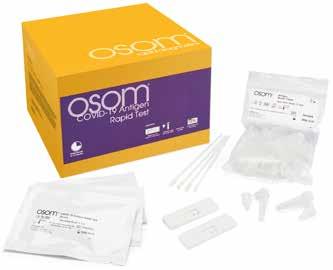
BE PREPARED FOR RESPIRATORY SEASONS WITH THE OSOM® COVID-19 ANTIGEN RAPID TEST
From Sekisui
The OSOM® COVID-19 Antigen Rapid Test is a lateral flow immunoassay that detects the SARS-CoV-2 nucleocapsid protein with a nasal swab in only 15 minutes at the point-of-care. The test is intended to be used by healthcare professionals or operators on patients suspected of COVID-19 within the first 7 days of symptom onset. The clinical performance compares favorably against polymerase chain reaction methodology, with a positive percent agreement of 95.1% and a negative percent agreement of 97%.
View Brochures, Videos & More at POR.io
Enter Number 3910 in the Search Area
OSOM® COVID-19 Antigen Rapid Test has not been FDA cleared or approved. It is authorized by FDA under an EUA for prescription use only. It has been authorized only for the detection of SARS-CoV-2 antigen, not for any other viruses or pathogens and is only authorized for the duration of the declaration that circumstances exist justifying the authorization of emergency use of in vitro diagnostics for detection and/or diagnosis of COVID-19 under Section 564(b)(1) of the Federal Food, Drug, and Cosmetic Act, 21 U.S.C S360bbb-3(b)(1), unless the authorization is terminated or revoked sooner.

 3911
3912
3913
3911
3912
3913
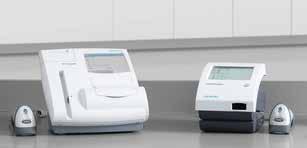
EARLY DETECTION AND MANAGEMENT OF CHRONIC CONDITIONS WITH DCA VANTAGE® AND CLINITEK STATUS®+ ANALYZERS
From Siemens Healthineers
Siemens Healthineers DCA Vantage® and CLINITEK Status® family of analyzers provide Hemoglobin A1c (HbA1c) and albumin-tocreatinine ratio (ACR) testing at the point of care. Monitor glycemic control in patients with diabetes and screening for kidney disease in patients at-risk, in-office. Enable real-time consultation, eliminating loss to follow-up. Improve the patient experience and overall outcome by providing actionable results in minutes.
CLIA-waived: DCA HbA1c; CLINITEK Microalbumin 2 (ACR)
CLIA Moderate Complexity: DCA® Microalbumin/Creatinine (ACR)
View Brochures, Videos & More at POR.io
Enter Number 3914 in the Search Area
QUANTAFLO® PAD
From Semler Scientific
QuantaFlo® PAD is an easy to use, accurate, point of care, non-invasive solution that aids in the early detection of peripheral arterial disease (PAD). This FDA cleared device can be administered by a medical aide in less than 5 minutes. As published in the Journal of Vascular Surgery and the American Journal of Preventive Medicine, QuantaFlo detected undiagnosed PAD in 31.6% of patients +65.1 QuantaFlo is portable and integrates with other technologies and platforms. It is ideal for both home and clinic environments.
1. Smolderen KG, Ameli O, Chaisson CE, Heath K, Mena-Hurtado C. Peripheral Artery Disease
Screening in the Community and 1-Year Mortality, Cardiovascular Events, and Adverse Limb Events, AJPM Focus (2022), https://doi.org/10.1016/j.focus.2022.100016
View Brochures, Videos & More at POR.io Enter Number 3915 in the Search Area 3916

Enter Number 3916 in the Search Area 3914

NOVA PRIMARY BLOOD GLUCOSE REFERENCE ANALYZER
From Nova Biomedical
The U.S. FDA has cleared Nova Primary as a blood glucose reference analyzer that fills the need for a new reference analyzer to replace the YSI STAT PLUS 2300 (YSI, Inc., Yellow Springs, OH). Manufacturers of blood glucose measuring devices and clinical diabetes researchers have relied on the YSI 2300 as a reference and correlation analyzer. However, YSI, Inc. no longer supports the analyzer, and its discontinuation has left a critical industry void. With today’s FDA clearance, Nova Primary from Nova Biomedical is now available in the U.S. and worldwide.
View Brochures, Videos & More at POR.io
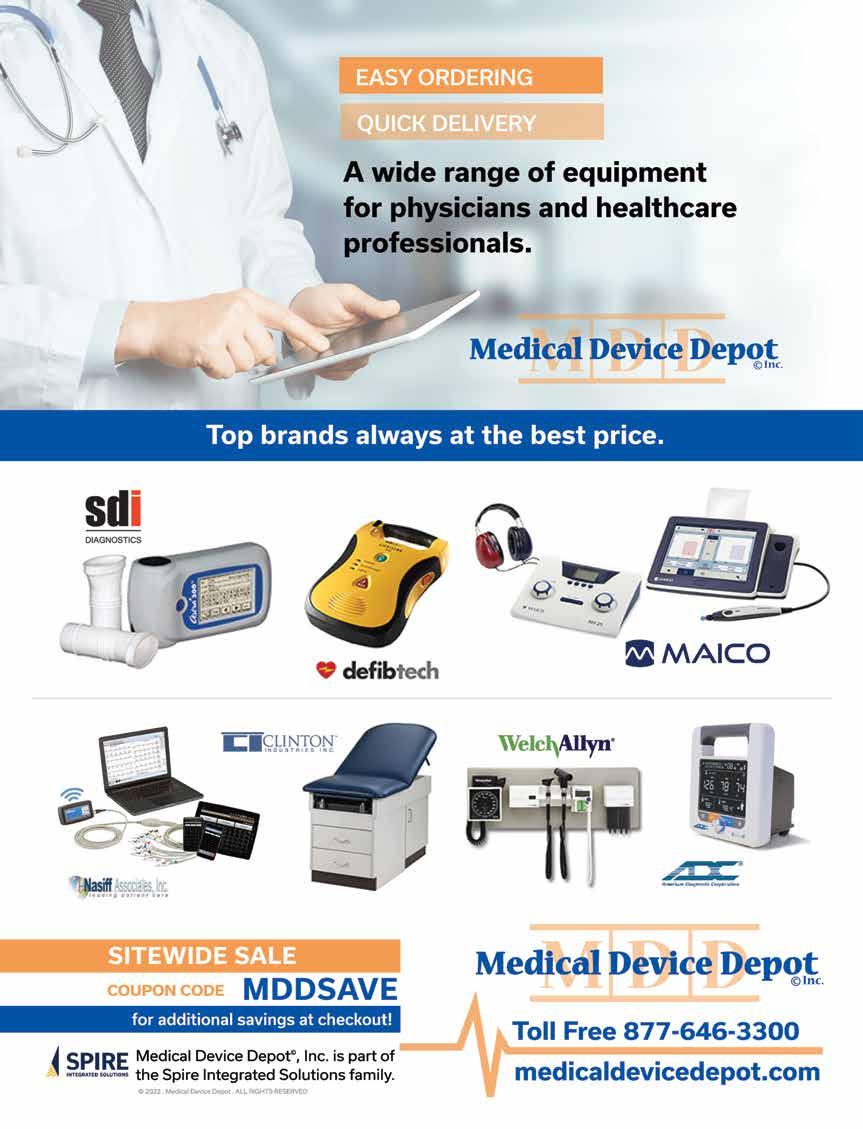
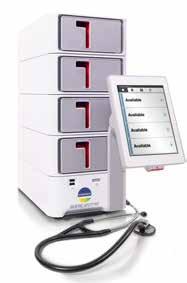
BIOFIRE SPOTFIRE
From bioMerieux
bioMérieux knows that an evolving world deserves evolved diagnostics. Our latest innovation, the BIOFIRE® SPOTFIRE® Respiratory Solution, is the first FDA-cleared and CLIA-waived COVID-19 testing solution. The BIOFIRE® SPOTFIRE® System is an easy-to-use system that runs the BIOFIRE® SPOTFIRE® Respiratory (R) Panel. Benefits of the SPOTFIRE Respiratory Solution include: 15 respiratory targets on 1 PCR test with results in about 15 minutes; minimal benchtop space with vertical scalability up to four modules; easy to use with an intuitive user interface.
View Brochures, Videos & More at POR.io
Enter Number 3925 in the Search Area
ACUCY INFLUENZA A&B TEST
From Sekisui Diagnostics
The Acucy™ Influenza A&B Test is for the rapid, qualitative detection of influenza A and B viral nucleoprotein antigens from both nasal and nasopharyngeal swabs. Utilizing the Acucy™ Reader in either the point-of-care or laboratory setting, workflow flexibility is achieved with both Read Now and Walk Away features. The combination provides clinicians with standardized and definitive result interpretation.
View Brochures, Videos & More at POR.io
Enter Number 3926 in the Search Area

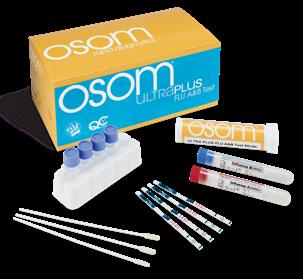
OSOM ULTRA PLUS FLU A&B TEST
From
Sekisui Diagnostics
Stronger Clinical Performance Takes Lateral Flow Testing To The Next Level. Providing superior rapid results at the point-of-care. Fast, easy, cost effective so you can test and treat in one visit.
• High Performance- Equivalent or exceeding the performance of reader devices, without the need for an instrument
• Results in 10 minutes
• OSOM® Custom Care- Exceptional Support/Training by licensed medical technologists and experienced healthcare professionals
• Made in the USA
View Brochures, Videos & More at POR.io
Enter Number 3927 in the Search Area
Comprehensive toxicology menu now with 14 CLIA 1 categorized moderate complexity assays.

IMMTOX ™ 270 BENCHTOP ANALYZER

Toxicology screening solutions for physician offices, pain management, treatment centers and laboratories testing 200+ patient samples/mo.
MODERATE COMPLEXITY ASSAYS – FDA 510(K) CLEARED
6-acetylmorphine (6-AM Heroin metabolite)
Amphetamine
Barbiturates
Benzodiazepines
Benzoylecgonine (Cocaine metabolite)
Buprenorphine
Cannabinoids (THC)

EDDP (Methadone metabolite)
Fentanyl*
Methamphetamine
Opiates
Oxycodone
Phencyclidine (PCP)
Tramadol
Scan this QR code to view the ImmTox™ 270 product video
3929

TURN SMALL PLACES INTO SMART SPACES
From Abbott
With reduced budgets, shrinking laboratory space and staffing challenges, many laboratories need a solution that lets them work smarter with less. The CELL-DYN Emerald 22 AL is a full performance, automated optical 5-part differential analyzer that delivers smarter results for small to midsize clinical laboratories.
• Compact Design
• Walkaway Functionality
• Ease Of Use
• Smart Safety Features
View Brochures, Videos & More at POR.io
Enter Number 3930 in the Search Area
HEMATOLOGY TESTING MADE EASY
From Sysmex
Designed for labs testing up to 25 samples per day, the Sysmex pocH-100i™ has the smallest footprint of any analyzer on the market. The instrument requires only 15uL of whole blood for reporting of 17 clinical parameters, including a 3-part WBC Differential. It is ideal for urgent care, physician office lab, small clinic, or any outpatient setting where a point of care CBC is needed.
View Brochures, Videos & More at POR.io
Enter Number 3929 in the Search Area


MICROS HEMATOLOGY ANALYZER WITH 3-PART DIFFERENTIAL PLUS THE LITEDM
From HORIBA Medical
Is it viral or bacterial? A CBC with 3-part differential can provide the clues to help distinguish between viral and bacterial infections before you decide to treat. The Micros 60 Hematology analyzer provides a CBC with 3-part Diff result in less than 60 seconds using only 10 µL of sample. Connect to the LiteDM Patient Data Management System for an affordable way to consolidate patient results to one report.
View Brochures, Videos & More at POR.io
Enter Number 3931 in the Search Area


MEN’S HEALTH: Preventing a Health Crisis
BY: MICHAEL BAKER, STAFF WRITER PHYSICIANS OFFICE RESOURCEI have a host of scars that I’ve acquired over the years. Truth be told, I don’t mind my scars. Each one comes with a different, sometimes funny, stupid, adventurous, or scary story. Not only do these scars carry memories, but they also represent triumph. To me is amazing to think each scar represents a time when my body failed but also shows how it was able to overcome that failure.
As a male, sometimes we’re a little more reckless with our bodies than our female counterparts. The average U.S. male lives to 76 years old compared to the average female life expectancy of 81 years old. Not only do men fall 5 years short in life expectancy, but one in every 5 U.S. men will die before the age of 65. The reasons being, males typically have poorer health habits, are less likely to seek medical attention and regular checkups, and face greater levels of stress. Despite these shortfalls, the good thing is many of these obstacles that men are facing are very preventable. While there are many things men can do to improve their overall health, in this article we’ll look at the following: improving their metabolic issues such has high cholesterol, being aware of their prostate cancer risks, and being attentive to hormone levels.
Cholesterol Levels
Poor cholesterol levels, especially high levels of LDL (low-density lipoprotein) cholesterol and low levels of HDL (high-density lipoprotein) cholesterol, can significantly impact health in several ways:
1. Increased risk of heart disease and stroke: High LDL cholesterol can lead to the accumulation of plaque in the arteries (atherosclerosis), narrowing them and restricting blood flow to the heart and brain, increasing the risk of heart disease and stroke.
2. Hypertension (high blood pressure): High LDL cholesterol can contribute to the development of hypertension, which is a significant risk factor for heart disease, stroke, and other cardiovascular complications.
3. Peripheral artery disease (PAD): Atherosclerosis caused
by high LDL cholesterol can also affect arteries supplying blood to the legs and arms, leading to PAD. PAD can cause pain, numbness, and tissue damage in the affected limbs.
4. Increased risk of heart attack: High levels of LDL cholesterol can lead to the formation of blood clots, which can block blood flow to the heart, causing a heart attack.
5. Increased risk of stroke: Atherosclerosis caused by high LDL cholesterol can also affect arteries supplying blood to the brain, increasing the risk of stroke.
6. Decreased kidney function: High cholesterol can lead to the formation of plaque in the arteries supplying blood to the kidneys, reducing kidney function over time.
7. Increased risk of other health problems: High cholesterol levels have also been linked to other health problems, such as gallstones and certain types of cancer.
To improve overall cholesterol levels
There are several lifestyle changes men can make to improve their cholesterol levels:
1. Healthy diet:
• Reduce saturated fats: Replace foods high insaturated fats with healthier options. For example, choose lean meats, such as chicken and fish, over red meat.
• Increase fiber intake: Foods high in soluble fiber, such as oats, barley, fruits, and vegetables, can help lower cholesterol.
• Limit dietary cholesterol: Reduce your intake of foods high in cholesterol, such as organ meats, egg yolks, and full-fat dairy products.
2. Regular exercise:
• Aim for at least 30 minutes of moderate-intensity exercise most days of the week. Activities like brisk
walking, jogging, swimming, or cycling can help raise HDL (good) cholesterol and lower LDL (bad) cholesterol.
3. Maintain a healthy weight:
• Losing excess weight can help lower LDL cholesterol and raise HDL cholesterol.
4. Quit smoking:
• Smoking lowers HDL cholesterol levels and damages the walls of your blood vessels, making them more prone to accumulating fatty deposits.
5. Limit alcohol intake:
• Drinking alcohol in moderation can raise HDL cholesterol. However, too much alcohol can lead to serious health problems, including high blood pressure and heart failure.
5. Medication:
• In some cases, medication may be necessary to help lower cholesterol levels, especially if lifestyle changes alone are not enough.
Prostate Screenings
Prostate cancer is the second most common cancer among men worldwide, with an estimated 1.4 million new cases diagnosed each year. While the thought of prostate cancer screening may seem daunting, understanding the purpose, process, and potential benefits can empower men to take charge of their health. Here’s what men need to know about prostate screenings.
The prostate is a small gland located just below the bladder and in front of the rectum. It plays a crucial role in the male reproductive system by producing seminal fluid. Prostate cancer occurs when cells in the prostate gland mutate and multiply uncontrollably.
Prostate cancer screenings are recommended for men 50 and older. The two primary screening tests for prostate cancer are the prostate-specific antigen (PSA) test and the digital rectal examination (DRE).
PSA Test: The PSA test measures the level of PSA in the blood. Elevated PSA levels may indicate the presence of prostate cancer, although other factors, such as age and prostate size, can also affect PSA levels. While an elevated PSA level does not necessarily mean cancer is present, it may prompt further testing, such as a biopsy.
Digital Rectal Examination (DRE): During a DRE, a healthcare provider inserts a gloved, lubricated finger into the rectum to feel for any abnormalities in the prostate gland. While a DRE can detect some prostate cancers, it is less effective than the PSA test at detecting early-stage cancers.
While screening may detect prostate cancer at an early, more treatable stage, it is not without risks. By understanding the purpose, process, and potential benefits and risks of prostate

screenings, men can make informed decisions about their health and well-being. Remember, early detection can significantly improve the chances of successful treatment and survival.
Male Menopause and Hormone Testing
Male menopause and andropause are terms used to describe decreasing levels of the testosterone in males that comes because of aging. In males, about 45-65% of testosterone is bound to sex hormone-binding globulin (SHGB) a protein produced mainly in the liver. The remaining 35-55% of the testosterone in the blood that is not bound is known as free testosterone. Risk factors for low SHGB include obesity, type 2 diabetes, hypothyroidism, Cushing syndrome, and nonalcoholic fatty liver disease. Testosterone and SHBG levels should be tested with the aging male population that are experiencing signs and symptoms of low testosterone.
Thinking back on my scars and the memories they carry, many of those scars were preventable. Most of us men need to remember we’re not as young as we used to be and most actions that lead to scars carry more negative consequences than they once did when we were young. Facing a health crisis is one thing, but for many men this health crisis is preventable.
3933

PERIPHERAL ARTERIAL DISEASE
QUANTAFLO® PAD
From Semler Scientific
QuantaFlo® PAD is an easy to use, accurate, point of care, non-invasive solution that aids in the early detection of peripheral arterial disease (PAD). This FDA cleared device can be administered by a medical aide in less than 5 minutes. As published in the Journal of Vascular Surgery and the American Journal of Preventive Medicine, QuantaFlo detected undiagnosed PAD in 31.6% of patients +65.1 QuantaFlo is portable and integrates with other technologies and platforms. It is ideal for both home and clinic environments.
1. Smolderen KG, Ameli O, Chaisson CE, Heath K, Mena-Hurtado C. Peripheral Artery Disease Screening in the Community and 1-Year Mortality, Cardiovascular Events, and Adverse Limb Events, AJPM Focus (2022), https://doi.org/10.1016/j.focus.2022.100016
View Brochures, Videos & More at POR.io
Enter Number 3933 in the Search Area
PAD TESTING SYSTEMS IDEAL FOR PRIMARY CARE TO VASCULAR SPECIALISTS
from Newman Medical
Your Patients Trust YOU To Find Their Peripheral Artery Disease
• High-risk patients include those over 65, diabetics, and smokers.
• If left untreated, 25% of patients with PAD will experience a heart attack or stroke within 5 years.
• PAD symptoms are often mistaken for arthritis or old age.
The simpleABI Cuff-Link System is Easy to Learn and Use.
• With a push-button remote, automatic calculations, and waveforms, it’s incredibly user-friendly.
• Reports are straightforward to save and share since the system is PC-based.
Outstanding Value and Reimbursements
• The system pays for itself in less than a year with just one test per week.
• Medicare reimbursements vary by exam and location, averaging from $91 to $174.
View Brochures, Videos & More at POR.io Enter Number 3934 in the Search Area


SYNDROMIC TESTING
BIOFIRE® FILMARRAY® TORCH
From bioMérieux
The BIOFIRE® FILMARRAY® TORCH is a fully integrated, random, and continuous-access system designed to meet your laboratory’s syndromic infectious disease testing needs. The benchtop footprint of the BIOFIRE TORCH saves precious lab space, and its scalability meets high throughput demands. BIOFIRE® FILMARRAY® Link Software automatically uploads patient results. Fully compatible with all BIOFIRE® FILMARRAY® Panels intended for use in CLIA-moderate settings, the BIOFIRE TORCH helps you maximize efficiency and productivity.
View Brochures, Videos & More at POR.io
Enter Number 3935 in the Search Area

ARTERY DISEASE
(PAD) is an often silent condition where narrowed arteries reduce blood flow to the legs, causing symptoms like leg pain, numbness, and slow-healing wounds.
HOW MANY OF THESE PATIENTS DO YOU HAVE? Atherosclerosis
Diabetics
Smokers
Over age 65
DON’T LET PAD SNEAK UP ON YOU OR THESE PATIENTS.
50% report no symptoms, while those that do attribute their pain to arthritis or “old age”.
EASY
No Doppler or vascular anatomy knowledge necessary. Can be done in five minutes or less by any staff member. Non-invasive, patient-friendly test.
ACCURATE
Accuracy equal or better than Doppler ABI. Useful for diabetics with calcified arteries.
REIMBURSABLE

THESE PATIENTS TRUST YOU TO FIND THEIR PAD
before they have a heart attack, stroke, or even die. PAD also leads to significant disability and reduced quality of life
Great ROI: the typical internist has 800 Medicare patients, per ACP. Testing five patients per week can pay for the system in less than two months. CPT 93923, with a national average of $142/exam.

With over 40 years of experience in diagnostic ultrasound, Newman Medical is a trusted leader in vascular testing solutions Newman's ABI-Q rapid-test system epitomizes their commitment to pioneering technology. Built on integrity and expertise, count on Newman Medical for precise, rapid, and reliable vascular testing solutions to learn how early PAD detection benefits both your patients and your practice


FOUR SEASONS RESORT ORLANDO AT WALT DISNEY WORLD RESORT
BY BRANDI BROWER, TRAVEL EDITORWhat was once the Eagle Pines and Osprey Ridge Golf Club transformed into the 26-acre Four Seasons Resort Orlando at Walt Disney World with the wave of a wand, a $370 million investment, and a little bit of pixie dust. Nestled within the Disney-developed Golden Oak residential community, multi-million dollar homes are neighbors to the 17-story, 560,000-square-foot, 443-room luxury edifice. The extensive property, ensconced by protected wetlands, natural woodlands, oaks, palms, lush grasses, and glittering lakes, was completed in 2014. The towering building, a nod to Spanish Revival-style architecture, is reminiscent of the resort hotels in South Florida over a century ago, features golden-era design elements of colonnades, French doors, columns and arches, loggias, variegated barrel tile roofs, and decorative metal work. Tile, stucco, and stone stand out against the beautiful lush landscaped grounds, the championship golf course, and a certified wildlife sanctuary.
After an anticipated pleasant valet and greeting by team members, I’m shown to the reception area, but only after passing the magnificent chandelier at the top of the grand spiral staircase. With more than 30,000 crystal components, the firework-inspired fixture is Instagram-worthy and a nod to the nightly Disney fireworks splendor visible at the Resort. It’s a dazzling display—I thought I saw the glimmer of a lost glass slipper on the marble-laden floor. This property would make anyone feel like they are in a fairy tale. It isn’t Cinderella’s castle, but the grand and elegant aesthetic is Bippity Boppity beautiful! (Borrowing words from the Fairy Godmother.) Despite being the only Resort on Disney World property not owned by the company, the Four Seasons does a tasteful job of bringing the magical elements but not Disneyfying the design.
This is not your momma’s Contemporary or Polynesian. The Four Seasons Resort Orlando at Walt Disney World is an award-winning AAA Five Diamond Resort. For the ten years it has been in operation, U.S. News & World Report recognized the palatial property as the #1 hotel in the Best Hotels and Resorts category in Walt Disney World. It ranked #2 Best in the state of Florida. Nationally, it boasts the #7 Best Hotel and #4 Best Resort in the U.S. for 2024. The annual evaluation ranks its exceptional experiences and high-quality amenities among the best, recognizing the unparalleled Resort’s offerings, its connections to Walt Disney World Resort, and its remarkable guest services for which the Four Seasons brand is known. That’s a lot of “bests”.
With so many people mixing business with leisure, this is a popular place for the “bleisure” trend. The Orange County Convention Center is the second largest convention center in the U.S., and Orlando tops the list of convention host cities. Many opt to bring their family to their conference or incentive trip, later enjoying the spoils of the Sunshine State. The Disney World parks are a prominent stop on that leisure bus. After discovering all the “bests” that the Four Seasons Resort offers, one may decide to stay solely onsite. Or, at least it promises a respite and reward after a Disney day of 20,000 steps, standing in sweaty lines, a couple of churros, and a Dole whip. Let’s dive into what makes the Four Seasons Resort Orlando a special staycation option.


Starting with the plethora of pool preferences, five water areas to splish and splash in. The first splish is in the Splash Zone, especially fun for the littles, with columns of choreographed, interactive fountains that blast water 30 feet into the air. Curtains of water spray down from the arched walls, making a playful place to park yourself and watch your kids have fun. The Family Pool is a 7,590-square-foot creatively curved, gradual sloping beach entry perfect for the young swimmers. With an infinity edge that overlooks the lake, favorite tunes on the underwater audio system, and “Dive-in” movies daily on the big screen. Disney’s Camp Rock was playing - “Is that Demi Lavato?” my husband queried, proving the Family Pool is fun for all ages. Next stop, The Drop. The Mansion, which houses pool tables, bocce ball, outdoor table tennis, a fireplace, and an observation deck, also connects to The Drop, two 242-foot water slides. One is encased in see-through fiberglass, and the other slide is open-air; both drops end in a big splash with lots of smiles. Rinse and repeat. Drifter’s Lazy River is a relaxing float with or without a tube, passing bubbling rapids and a cascading 9-foot waterfall. If that isn’t challenging enough to prevent your hair from getting wet... two spray cannons armed by two children who discovered my semi-dry hair, I instantly became the perfect target. Can you blame them? Lastly, after all the family

fun, The Oasis is an adults-only pool; it’s a tranquil phone and music-free zone where you can relax in the whirlpool and sip on drinks or snack on food delivered to you in your bungalow or chaise lounge. In all my travels, this is the first time I have seen a resort with as many pools and five+ acres of H2O entertainment, all of which serve their purpose and provide several options for aquatic nirvana.
There are many alternatives on the property for active guests hoping to challenge their bodies or improve their game. Four Seasons enhanced the original 18-hole golf track. A Tom Fazio design, what was once the Osprey Ridge, a part of the Disney Golf Collection, became the Tranquilo Golf Course at Four Seasons Golf and Sports Club Orlando.
The private, par-71 course is a true out-and-back layout surrounded by relative wilderness. It’s easy to forget you’re within a few miles of amusement parks. Walt Disney’s empire was built atop swamp land, so purposefully, very few water hazards exist. Instead, Fazio opted for sand hazards to challenge your round. The good news is that there’s less stress about losing golf balls. Improving your game is easy with the professional private instruction and short game evaluation options available, or work on your skills autonomously on the 16-acre practice facility with course-like undulating target greens. If swinging a club isn’t your racket, grab a racquet and enjoy a tennis clinic or private lesson on one of the three Har-Tru tennis courts.
Onsite recreation is wider than golf and tennis; the Resort offers a basketball court, sand volleyball court on Explorer Island, and even a rock climbing wall. The 24-hour Fitness Centre of-
fers personal instruction from certified trainers, with state-ofthe-art equipment: Peloton bikes, Matrix weight machines, and LifeFitness cardio machines; try a FitnessOnDemand class via a large screen T.V. or join in on one of the fitness classes held every morning throughout the week. If your young ones are making it difficult to find time for self-care or personal wellness, the Four Seasons famed Kids For All Seasons is always a windfall for parents. Supervised activities for children ages 4-12 are complimentary and available from 9-5, with flexibility in drop-offs/pick-ups. The option to leave your child with excellent staff to play with other children in a fun environment so that you can recharge is a win/win for everyone. For the older kids, a rec room called The Hideout is a hangout where the teens can play foosball and video games and relax while sipping custom mocktails from the special menu.
The property has five dining options for real cocktails and special menus. Top of the list is at the top of the hotel, a rooftop steak house on the 17th floor. Capa is a source of pride for the Resort, as it has been awarded a Michelin Star rating for the past three years, receiving the distinction once again in April 2024. The Spanish-influenced hot spot features woodfired prime cuts, Floridian seafood, delectable tapas, and New Basque-inspired small plates. The atmosphere pairs well with the menu’s Spanish influence and the exterior’s Spanish-revival architecture. Another feather in the Capa -the restaurant received recognition from the Embassy of Spain, certifying that the menu comprises 48% Spanish dishes and 60% wines from Spain, procuring the prestigious “Restaurants of Spain” certification. Epcot can’t give you that!
We enjoyed many dishes, including our favorite tapas - Pan
Con Tomate and the Datiles, Medjool Dates, Almonds, Bacon, and Tamarind. The 12 oz. Delmonico, Platinum X Wagyu, Black Garlic Puree, and Cilantro Horseradish, which I also ordered on the side. My husband said I would ruin the flavor of the incredible cut, but I loved the extra kick. A Maize, Polenta, Goat Cheese, and Sherry Vinegar side dish rounded off the entree. Our server, Alan, was exceptional in his knowledge of the menu, helping us pair down to our final selections, as well as his pacing of the meal so that we could take a brief break from the gastronomy and enjoy the incredible view and the firework display of the Magic Kingdom and Epcot from the large terrace. The colorful spectacle was a sweet ending to the evening, but an even sweeter finale came in the form of our dessert. Executive Pastry Chef Rabii Saber, a James Beard Awards finalist, has made his mark in the art of confectionary creations. A platter with an assortment of delectables was a memory maker: White Chocolate, Coconut Sorbet, Mango Passion center, an Olive Oil Cake, Mixed Berries Sorbet, Lemon Cream, Pistachio Mousse, and Churros de Madrid, chocolate and dulce dipping sauces, definitely not your average Disney churros.
Not to be missed, Ravello, Italian cuisine, is also a high-ranking restaurant, recently recognized with “100 percent Italian Taste Certification” at the highest Platinum level. Ravello is the first in the U.S. to receive this designation, and its incredible homemade pasta dishes are undoubtedly worthy of it. We started with Meatballs, Mortadella, Prosciutto, Pomodoro Sauce, Mascarpone, and Grilled Pane Pugliese; my main dish was an exceptional Rigatoni, Parmigiano Reggiano Cream Sauce, Basil Pesto, Roasted Garlic, and Spinach. Even my granddaughter’s cheese pizza was the best I have ever tasted, and this was off the kid’s menu! Keeping with the tradition of extraordinary staff, our server, Katie, was both great with pasta suggestions and entertaining for our little two-year-old. By night, it’s Italian cuisine; by day, it’s breakfast fare; and on two special mornings a week, it’s Good Morning with Goofy and his Pals. What a fantastic opportunity it is to have the proximity of a character breakfast on site and the level of dining to accompany the experience. It is perfect. You can never go wrong with a Four Seasons decadent buffet, and you add a dash of Minnie, Mickie, and Goofy to the recipe, mixed with the joyful expressions of your grandchild, and that’s an unforgettable event. A photographer is there to capture the cute moments and exchanges with each of the Disney friends that come to the table. My granddaughter is young and won’t remember her blowing a kiss to Mickey or hugging Minnie, but we will.
Additional foodie highlights: We enjoyed the Grilled Fish Tacos and Greek Salad from the PB&G, the Pool Bar and Grill serving al fresco American fare lakeside. Also, a pop into the Lickety Split is a must. They offer grab-n-go sandwiches, salads, breakfast bites, and artisanal coffees, but Pastry Chef Rabii Saber’s house-made gelatos are a must. There are so many flavors, and unfortunately, my resort visit wasn’t long enough to try them all. Modern Latin-American cuisine and clubhouse favorites at Plancha, located at the Tranquilo Golf Course, with views of the lake and champion links. Rounding out the dining options, casual ambiance, creative cuisine, and cocktails at The Lobby Bar.


It’s challenging to keep it brief when sharing thoughts on Four Seasons cuisine because it is notoriously good. But by the same token, brevity with the sumptuous accommodations is also tricky, as there is so much to love about the rooms. As we walked into our 7th Floor Park View Deluxe Suite, I could tell immediately that this would be no exception to the rule of luxury that is Four Seasons. A wave of calm washes over me from the minute I walk in the door. It’s 1000 s.f. of blissful space, recently re-imagined by Parker Torres Design of Boston. Modern and elegant are the first words that come to mind to describe the serene sanctuary. According to the lead designer on the project, Kristen Emory, the goal was “for guests to feel enveloped in an atmosphere that stimulates the senses while also evoking a feeling of tranquility.”
Mission accomplished. The natural color palette, grey, soft blush, taupe, and surprise pops of greens and blues, combined with contemporary textures and patterns, create a homey hideaway. The herringbone tiled entry, with a marble-topped console, coat closet, walnut wall treatment, and artwork, gives the residential vibe like I’m coming home. As much as the property steers clear of Disney decor, according to Emory, there are hid-
den homages to the theme park, “Woven within the richly layered elements, whimsical and playful details will remind guests of the magic experienced at this iconic destination.” (Upon reading this fact, I quickly brought up my photos of the suite and located the floral motif art on the wall, enlarging it to hunt for the honey pot, star, and castle hidden. I couldn’t find the star.) These playful touches and the attention to detail, like the various locations in the suite with USB-C chargers, are a consideration of the guest experience and what will make their stay more comfortable. A bathroom with a marble vanity sink, striking turquoise blue diamond tiles adorn the wall, and a generous walk-in shower serves as an additional grooming space.
As you enter the living space, the blonde wide plank oak floors balance with the darker walnut wood accents on the walls and furniture. Lighting plays a dramatic role in the design, with several dimming options, striking fixtures, sconces, rope lighting around the bed frame and panel accents. The comfy sectional sofa hides a generous-sized sleeper bed, and adjacent is a large wall-mounted television, and below rests a custom-built console housing a coffee bar and refrigerator; paired on the side rests an attractive bar cart, built into the corner is a beautiful banquet with dining table and two chairs for in-room dining, floor to ceiling windows and a slider beckons guests to enjoy the expansive balcony that extends access over to the bedroom, two patio chaise loungers, four chairs and table waiting for al fresco dining while soaking in the sunsets.
A privacy door opens into the ample primary bedroom, and the scenery from the balcony pops with the black framing of the windows and sliding door. An oversized rounded cushion chair is an inviting spot with comfy pillows and a reader lamp behind it; all you need is a good book. A textured two-tone dresser sits below the 65-inch flatscreen T.V. neighboring the king bed. The bed, the glorious Four Seasons bed! The renowned mattress, sheets, and white-on-white duvet with monogrammed tree insignia shams ~ “Where dreams really do come true.”
The attractive double-arched hall introduces you to the principal bathroom, passing through flanking closets on either side. With dual built-in drawers and marble valet tops, there is ample space for personal items. An ingenious, completely mirrored pocket door provides privacy into the lux lavatory, which is fully useful for dressing and visually echos the space, making the footprint feel even more significant. The bathroom features double sinks, a completely mirrored wall with generous lighting, a large shower, and the focal point, a deep stand-alone soaking tub with a glittering mosaic tile design on the wall as an accent. Thirsty Four Seasons robes, citrus-smelling Atelier Cologne bath products, and rooms serviced twice daily, making some sweet finishing touches.
If the room relaxation isn’t adequately satisfying, you must go to The Spa for some self-indulgence. The secluded and expansive indoor and outdoor lounges are complimentary for
resort guests and are the perfect place to unwind. Beautifully appointed, the indoor relaxation area with a cozy fireplace, comfy chairs, tea, and snacks, or choose the outside area with relaxing cushioned chaises, a whirlpool, and a waterfall feature. The women’s and men’s locker rooms offer equal pampering with vanity areas, showers, steam rooms, ice stations, and The Experience Shower. Upon entering, you select which program you want to experience on the keypad, and then various sound effects, variegated lighting, and assorted water pulsations from several angles occur. I tried them all; the Tropical Storm setting was my favorite.
The gorgeous 13,000-square-foot haven will honor any spa service imaginable. With 18 treatment rooms named after birds indigenous to Florida, the certified specialists offer a comprehensive collection of effective therapies. These professionals will perform their rejuvenating magic through advanced aesthetic services, body therapies, or simply hair, makeup, and nails. With over 50 options on the menu, there is nothing you could want that this Orlando oasis couldn’t provide. The Spa also offers Magical Moments for Kids, mini makeovers for the little people in your life; with Belle of the Ball or Shining Knight experiences, children receive the royal treatment and leave feeling like a prince or princess. I couldn’t leave without trying one of the array of options available. My choice was the Somadome, where I was cocooned with a dome over my upper body, privately in a treatment room, seated in the Somadome chair with headphones on. After selecting an intention, the 20-minute personalized meditation utilizes binaural beats, energy medicine with magnets, and crystal and color therapy to assist in a mental mending session. It felt like I was in Tomorrowland in the Magic Kingdom, a glimpse into the future of healing.
Speaking of the Magic Kingdom, there’s a bit of competition in Orlando for the title of The Most Magical Place on Earth. It resides at 10100 Dream Tree Boulevard, an incredible property where glam and lux coexist with the wild and natural beauty of the Everglades. Four Seasons Resort, Orlando, at Walt Disney World Resort, casts a powerful spell on its guests. They come to enjoy the proximity to Disney World, yet the elegance and family-friendly magic the team has spun together make this castle a hard place to want to leave. The benefits of being on the Disney World property include Early Theme Park Entry, allowing guests access 30 minutes before the parks open, and Disney Cast Members onsite to assist with planning the perfect park dining reservations and itinerary. Four Seasons also provides transportation to and from the theme parks. As a guest here, you’re removed from the Mickey madness; however, if you choose to conquer the crowds and ride the rides, it is like a gift from a Fairy Godmother to know that at the end of the very long day, the Four Seasons palatial property is where you’ll find respite and peace.
If the glass slipper fits, you should wear it.
www.fourseasons.com/orlando





MDescapes features exclusive luxury travel discounts and offers! Our goal is to reward you, the healthcare professional, and help provide the rest, adventure, and memoires that accompany a luxury vacation.



